Jujube
Ziziphus jujuba (from Greek ζίζυφον, zízyphon[2]), commonly called jujube[3] (/ˈdʒuːdʒuːb/; sometimes jujuba), red date, Chinese date,[3] is a species of Ziziphus in the buckthorn family (Rhamnaceae).
| Jujube | |
|---|---|
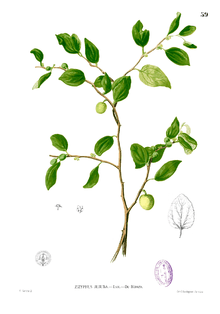 | |
| Plate from the book Flora de Filipinas | |
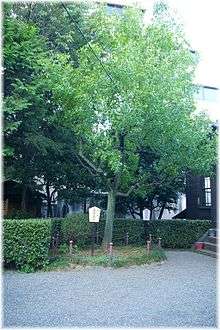 | |
| Ziziphus jujuba, habitus | |
| Scientific classification | |
| Kingdom: | Plantae |
| Clade: | Tracheophytes |
| Clade: | Angiosperms |
| Clade: | Eudicots |
| Clade: | Rosids |
| Order: | Rosales |
| Family: | Rhamnaceae |
| Genus: | Ziziphus |
| Species: | Z. jujuba |
| Binomial name | |
| Ziziphus jujuba | |
| Synonyms[1] | |
| |
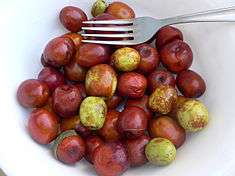 Fresh jujube fruit | |
| Nutritional value per 100 g (3.5 oz) | |
|---|---|
| Energy | 331 kJ (79 kcal) |
20.23 g | |
0.2 g | |
1.2 g | |
| Vitamins | Quantity %DV† |
| Vitamin A equiv. | 5% 40 μg |
| Thiamine (B1) | 2% 0.02 mg |
| Riboflavin (B2) | 3% 0.04 mg |
| Niacin (B3) | 6% 0.9 mg |
| Vitamin B6 | 6% 0.081 mg |
| Vitamin C | 83% 69 mg |
| Minerals | Quantity %DV† |
| Calcium | 2% 21 mg |
| Iron | 4% 0.48 mg |
| Magnesium | 3% 10 mg |
| Manganese | 4% 0.084 mg |
| Phosphorus | 3% 23 mg |
| Potassium | 5% 250 mg |
| Sodium | 0% 3 mg |
| Zinc | 1% 0.05 mg |
| Other constituents | Quantity |
| Water | 77.86 g |
| |
| †Percentages are roughly approximated using US recommendations for adults. Source: USDA Nutrient Database | |
Jujube fruit naturally turns red upon drying. | |
| Nutritional value per 100 g (3.5 oz) | |
|---|---|
| Energy | 1,201 kJ (287 kcal) |
73.6 g | |
1.1 g | |
3.7 g | |
| Vitamins | Quantity %DV† |
| Vitamin A equiv. | 0% 0 μg |
| Thiamine (B1) | 18% 0.21 mg |
| Riboflavin (B2) | 30% 0.36 mg |
| Niacin (B3) | 3% 0.5 mg |
| Vitamin B6 | 0% 0 mg |
| Vitamin C | 16% 13 mg |
| Minerals | Quantity %DV† |
| Calcium | 8% 79 mg |
| Iron | 14% 1.8 mg |
| Magnesium | 10% 37 mg |
| Manganese | 15% 0.305 mg |
| Phosphorus | 14% 100 mg |
| Potassium | 11% 531 mg |
| Sodium | 1% 9 mg |
| Zinc | 2% 0.19 mg |
| Other constituents | Quantity |
| Water | 19.7 g |
| |
| †Percentages are roughly approximated using US recommendations for adults. Source: USDA Nutrient Database | |
Description
It is a small deciduous tree or shrub reaching a height of 5–12 metres (16–39 ft), usually with thorny branches. The leaves are shiny-green, ovate-acute, 2–7 centimetres (0.79–2.76 in) long and 1–3 centimetres (0.39–1.18 in) wide, with three conspicuous veins at the base, and a finely toothed margin. The flowers are small, 5 mm (0.20 in) wide, with five inconspicuous yellowish-green petals. The fruit is an edible oval drupe 1.5–3 centimetres (0.59–1.18 in) deep; when immature it is smooth-green, with the consistency and taste of an apple with lower acidity, maturing brown to purplish-black, and eventually wrinkled, looking like a small date. There is a single hard kernel, similar to an olive pit,[4] containing two seeds.
_Foliage_at_Ammuguda_01.jpg)
Distribution
Its precise natural distribution is uncertain due to extensive cultivation, but is thought to be in southern Asia, between Lebanon, northern India, and southern and central China, and possibly also southeastern Europe though more likely introduced there.[4]
This plant has been introduced in Madagascar and grows as an invasive species in the western part of the island. This plant is known as the "hinap" or "finab" in the eastern part of Bulgaria where it grows wild but is also a garden shrub, kept for its fruit. The fruit is picked in the autumn. The trees grow wild in the eastern Caribbean, and are reported to exist in Jamaica, The Bahamas, and Trinidad as well. In Antigua and Barbuda, the fruit is called "dumps" or "dums"; and in The Bahamas, "juju". It is also known as "pomme surette" on the French islands of the Caribbean. This fruit, more precisely known as "Indian jujube" elsewhere, is different from the "jujube" fruit that is cultivated in various parts of southern California.[5][6] Altun Ha, an ancient Mayan city in Belize, located in the Belize District about 50 kilometres (31 mi) north of Belize City and the surrounding woods, also boasts some jujube tree and shrub varieties where it is referred to as plums for lack of a better word among locals.
Nomenclature
The species has a curious nomenclatural history, due to a combination of botanical naming regulations, and variations in spelling. It was first described scientifically by Carl Linnaeus as Rhamnus zizyphus, in Species Plantarum in 1753. Later, in 1768, Philip Miller concluded it was sufficiently distinct from Rhamnus to merit separation into a new genus, which he named Ziziphus jujube, using Linnaeus' species name for the genus but with a probably accidental single letter spelling difference, "i" for "y". For the species name, he used a different name, as tautonyms (repetition of exactly the same name in the genus and species) are not permitted in botanical naming. However, because of Miller's slightly different spelling, the combination of the earlier species name (from Linnaeus) with the new genus, Ziziphus zizyphus, is not a tautonym, and was therefore permitted as a botanical name. This combination was made by Hermann Karsten in 1882.[4][7] In 2006, a proposal was made to suppress the name Ziziphus zizyphus in favor of Ziziphus jujuba,[8] and this proposal was accepted in 2011.[9] Ziziphus jujuba is thus the correct scientific name for this species.
Cultural and religious references
In Arabic-speaking regions the jujube and alternatively the species Z. lotus are closely related to the lote-trees (sing. "sidrah", pl. "sidr") which are mentioned in the Quran,[10][11] while in Palestine it is rather the species Z. spina-christi that is called sidr.[12]
Varieties
Varieties of jujube include Li, Lang, Sherwood, Silverhill, So, Shui Men and GA 866.[13]
Cultivation and uses
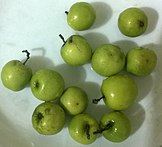
Jujube was domesticated in south Asia by 9000 BC.[14] Over 400 cultivars have been selected.
The tree tolerates a wide range of temperatures and rainfall, though it requires hot summers and sufficient water for acceptable fruiting. Unlike most of the other species in the genus, it tolerates fairly cold winters, surviving temperatures down to about −15 °C (5 °F) and the tree is for instance commonly cultivated in Beijing. This enables the jujube to grow in mountain or desert habitats, provided there is access to underground water throughout the summer. The jujube, Z. jujuba grows in cooler regions of Asia. Five or more other species of Ziziphus are widely distributed in milder climates to hot deserts of Asia and Africa.[15]
In Madagascar, jujube trees grow extensively in the western half of the island, from the north all the way to the south. It is widely eaten by free-ranging zebus, and its seeds grow easily in zebu feces. It is an invasive species there, threatening mostly protected areas.

Culinary use
The freshly harvested, as well as the candied dried fruit, are often eaten as a snack, or with coffee. Smoked jujubes are consumed in Vietnam and are referred to as black jujubes.[16] Both China and Korea produce a sweetened tea syrup containing jujube fruit in glass jars, and canned jujube tea or jujube tea in the form of teabags. To a lesser extent, jujube fruit is made into juice and jujube vinegar (called 枣 醋 or 红枣 醋 in Chinese). They are used for making pickles (কুলের আচার) in west Bengal and Bangladesh. In China, a wine made from jujube fruit is called hong zao jiu (红枣酒).
Sometimes pieces of jujube fruit are preserved by storing them in a jar filled with baijiu (Chinese liquor), which allows them to be kept fresh for a long time, especially through the winter. Such jujubes are called zui zao (醉枣; literally "drunk jujube"). The fruit is also a significant ingredient in a wide variety of Chinese delicacies (e.g. 甑糕 jing gao, a steamed rice cake).
In Vietnam and Taiwan, fully mature, nearly ripe fruit is harvested and sold on the local markets and also exported to Southeast Asian countries.[17] The dried fruit is used in desserts in China and Vietnam, such as ching bo leung, a cold beverage that includes the dried jujube, longan, fresh seaweed, barley, and lotus seeds.[17]
In Korea, jujubes are called daechu (대추) and are used in daechucha teas and samgyetang.
In Croatia, especially Dalmatia, jujubes are used in marmalades, juices, and rakija (fruit brandy).
On his visit to Medina, the 19th-century English explorer, Sir Richard Burton, observed that the local variety of jujube fruit was widely eaten. He describes its taste as "like a bad plum, an unrepentant cherry and an insipid apple." He gives the local names for three varieties as "Hindi (Indian), Baladi (native), Tamri (date-like)."[18] In Palestine a hundred years ago, a close variety was common in the Jordan valley and around Jerusalem.[19] The bedouin valued the fruit, calling it nabk. It could be dried and kept for winter or made into a paste which was used as bread.[20]
In Persian cuisine, the dried drupes are known as annab, while in neighboring Azerbaijan, it is commonly eaten as a snack, and is known as innab. Confusion in the common name apparently is widespread. The innab is Z. jujuba: the local name ber is not used for innab. Rather, ber is used for three other cultivated or wild species, e.g., Z. spina-christi, Z. mauritiana, and Z. nummularia in parts of India and is eaten both fresh and dried. The Arabic name sidr is used for Ziziphus species other than Z. jujuba.
Traditionally in India, the fruit is dried in the sun and the hard nuts are removed. Then, it is pounded with tamarind, red chillies, salt, and jaggery. In some parts of the Indian state of Tamil Nadu, fresh whole ripe fruit is crushed with the above ingredients and dried under the sun to make cakes called ilanthai vadai or regi vadiyalu (Telugu).[21] It is also commonly consumed as a snack.
In Northern and Northeastern India the fruit is eaten fresh with salt and chilli flakes and also preserved as candy, jam or pickle with oil and spices.
In Madagascar, jujube fruit is eaten fresh or dried. People also use it to make jam. A jujube honey is produced in the Atlas Mountains of Morocco.[17]
Italy has an alcoholic syrup called brodo di giuggiole.[22] In Senegal Jujube is called Sii dem and the fruit is used as snack. The fruit is turned into dried paste used by school kids.
The commercial jujube candy popular in movie theaters originally contained jujube juice but now uses other flavorings.
Medicinal use
The fruit and its seeds are used in Chinese and Korean traditional medicine, where they are believed to alleviate stress,[23] and traditionally for anti-fungal, anti-bacterial, anti-ulcer, anti-inflammatory purposes and sedation,[24] antispastic, antifertility/contraception, hypotensive and antinephritic, cardiotonic, antioxidant, immunostimulant, and wound healing properties.[25] It is among the fruits used in Kampo. Jujube, along with Gan Cao, is used in Chinese medicine to harmonize and moderate other herbs.
Ziziphin, a compound in the leaves of the jujube, suppresses the ability to perceive sweet taste.[26]
Other uses
In Japan, the natsume has given its name to a style of tea caddy used in the Japanese tea ceremony, due to the similar shape.[27] Its hard, oily wood was, along with pear, used for woodcuts to print the world's first books, starting in the 8th century and continuing through the 19th in China and neighboring countries. As many as 2000 copies could be produced from one jujube woodcut.[28]
In China, the leaves are sometimes picked for teas, such as by families in Laoshan Village, Shandong Province, China, where it counts as a variety of herbal tea.
The timber is sometimes used for small items, such as tuning pegs for instruments.
Pests and diseases
Witch's brooms, prevalent in China and Korea, is the main disease affecting jujubes, though plantings in North America currently are not affected by any pests or diseases.[29] In Europe, the last several years have seen some 80%–90% of the jujube crop eaten by insect larvae (see picture), including those of the false codling moth, Thaumatotibia (Cryptophlebia) leucotreta.[30]
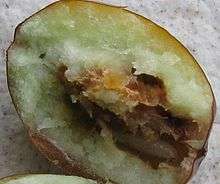
See also
- Date palm – palm tree cultivated for its edible sweet fruit
- Jujube (confectionery)
References
- The Plant List: A Working List of All Plant Species, retrieved 24 March 2016
- ζίζυφον, Henry George Liddell, Robert Scott, A Greek-English Lexicon, on Perseus Digital Library
- "Ziziphus jujuba". Germplasm Resources Information Network (GRIN). Agricultural Research Service (ARS), United States Department of Agriculture (USDA). Retrieved 11 December 2017.
- Rushforth, K. (1999). Trees of Britain and Europe. Collins ISBN 0-00-220013-9.
- "Indian Jujube". www.hort.purdue.edu.
- "JUJUBE Fruit Facts". www.crfg.org.
- Clarke, D. L. (1988). W. J. Bean Trees and Shrubs Hardy in the British Isles, Supplement. John Murray ISBN 0-7195-4443-2.
- Kirkbride, Joseph H.; Wiersma, John H.; Turland, Nicholas J. (2006). "(1753) Proposal to conserve the name Ziziphus jujuba against Z. zizyphus (Rhamnaceae)". Taxon. International Association for Plant Taxonomy. 55 (4): 1049–1050. doi:10.2307/25065716. JSTOR 25065716.
- Barrie, Fred R. (2011). "Report of the General Committee: 11". Taxon. International Association for Plant Taxonomy. 60 (4): 1211–1214. doi:10.1002/tax.604026.
- Abdullah, Yusuf Ali (1946) The Holy Qur-an. Text, Translation and Commentary, Qatar National Printing Press. p.1139, n. 3814.
- Stephen Lambden. "The Sidrah (Lote-Tree) and the Sidrat al-Muntaha (Lote-Tree of the Extremity): Some Apects of their Islamic and Bābī-Bahā'ī Iintepretations". Archived from the original on 6 September 2004. Retrieved 9 December 2015.
This is apparently the wild jujube or Zizyphus spina-christi (Christ's thorn), a tall, stout, tropical tree (see image above) with dense prickly branches which produces a sweet reddish fruit similar to that of the jujube (the 'unnāb = Zizyphus vulgaris / fruit)
- Easton, M.G., M.A., D.D. (1893). Illustrated Bible Dictionary and Treasury of Biblical History, Biography, Geography, Doctrine, and Literature. London, Edinburgh and New York: T. Nelson and Sons. p. 688.CS1 maint: multiple names: authors list (link)
- Edward T. Hager. "Jujubes: Plant Care and Collection of Varieties". garden.org. Retrieved 5 July 2017.
- Gupta, Anil K. "Origin of agriculture and domestication of plants and animals linked to early Holocene climate amelioration", Current Science, Vol. 87, No. 1, 10 July 2004, 54-59. Indian Academy of Sciences.
- S. Chaudhary. "Rhamnaceae" in: S. Chaudhary (Ed). Flora of the Kingdom of Saudi Arabia. Vol II (Part One) 2001.
- "Rare Fruit: Jujubes". Seasonalchef.com. Retrieved 1 August 2010.
- Edible Medicinal and Non-Medicinal Plants. Volume 5, Fruits. Lim, T.K. Dordrecht: Springer Science+Business Media. 2013. p. 580. ISBN 978-9400756526.CS1 maint: others (link)
- Burton, Sir Richard Francis (1855) A Personal Narrative of a Pilgrimage to Al-Madinah and Meccah pp.404,405
- Easton, M.G., M.A., D.D. (1893) 'Illustrated Bible Dictionary and Treasury of Biblical History, Biography, Geography, Doctrine, and Literature With Numerous Illustrations and Important Chronological Tables and Maps. T. Nelson and Sons, London, Edinburgh and New York. p.688. "It overruns a great part of the Jordan valley."
- Crowfoot, M. Grace with Louise Baldenserger (1932) From Cedar to Hyssop. A study in the Folklore of Plants in Palestine. The Sheldon Press, London. pp.112,113
- "Kamala's Corner: Indian Jujube – Elanthai Pazham". Kamalascorner.com. Retrieved 1 August 2010.
- "La pastinaca di Santu Pati". www.quoquo.it.
- Goetz P. "Demonstration of the psychotropic effect of mother tincture of Zizyphus jujuba" Phytotherapie 2009 7:1 (31–36) https://doi.org/10.1007/s10298-008-0362-7 Mise en évidence d’un effet psychotrope de la teinture mère de Zizyphus jujuba Mill (original French title)
- Jiang J.-G., Huang X.-J., Chen J., Lin Q.-S.,"Comparison of the sedative and hypnotic effects of flavonoids, saponins, and polysaccharides extracted from Semen Ziziphus jujube", Natural Product Research 2007 21:4 (310–320) https://doi.org/10.1080/14786410701192827
- Mahajan R.T., Chopda M.Z. "Phyto-pharmacology of Ziziphus jujuba mill – A plant review" Mahajan R.T., Chopda M.Z. Pharmacognosy Reviews 2009 3:6 (320–329)
- Kurihara, Y. (1992). "Characteristics of antisweet substances, sweet proteins, and sweetness-inducing proteins". Crit Rev Food Sci Nutr. 32 (3): 231–252. doi:10.1080/10408399209527598. PMID 1418601.
- Martin, Laura C. (2007). Tea: the Drink that Changed the World. Rutland, Vermont: Tuttle. p. 91. ISBN 978-0-8048-3724-8.
- edX Course: HarvardX: HUM1.3x Print and Manuscript in Western Europe, Asia and the Middle East (1450-1650) > Comparandum: Printing in East Asia > Main Technology: Xylography
- Fruit Facts: Jujube
- "Fact Sheet: False codling moth - Citrus Pests". idtools.org.
Further reading
- Fruits of Warm Climates. Julia. F. Morton, Yan Lin Aung, FL: 1986.
| Wikimedia Commons has media related to Ziziphus jujuba. |